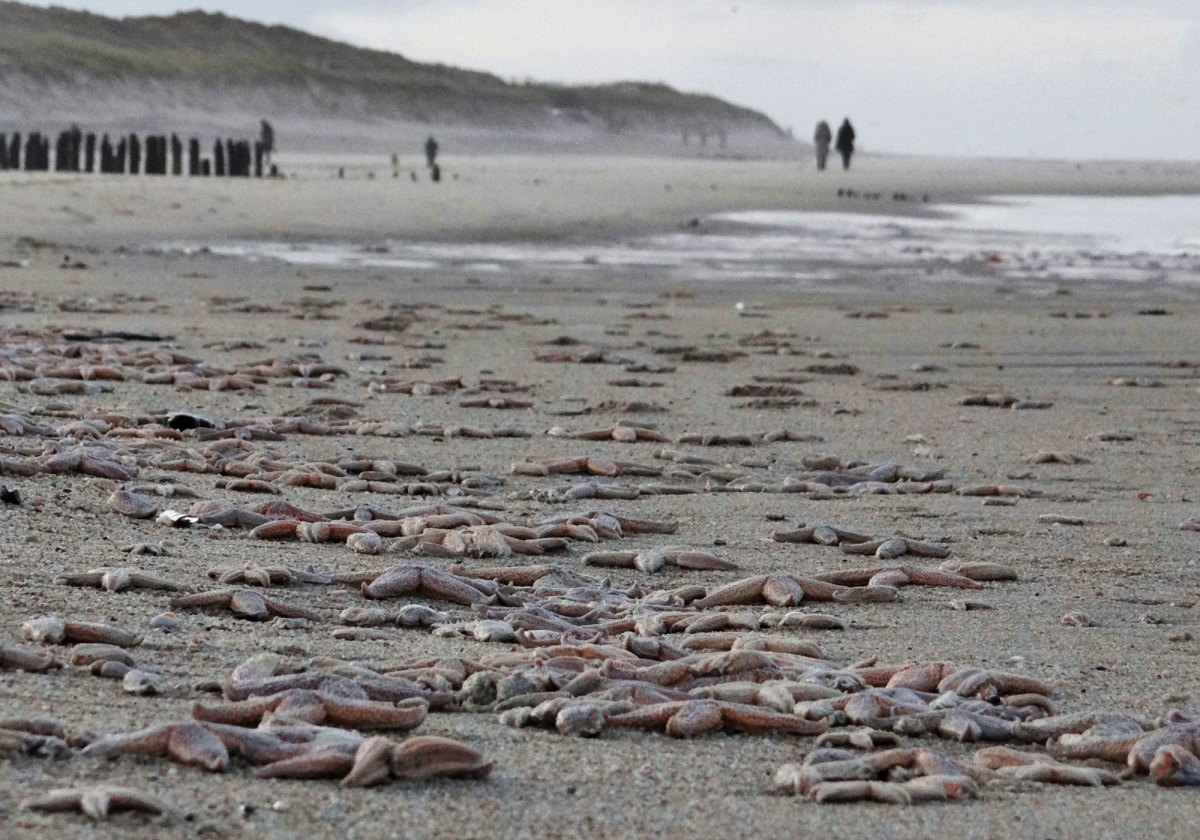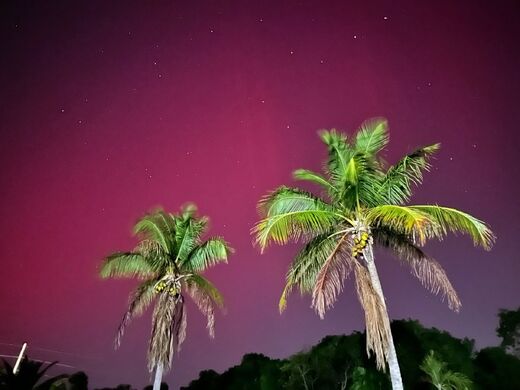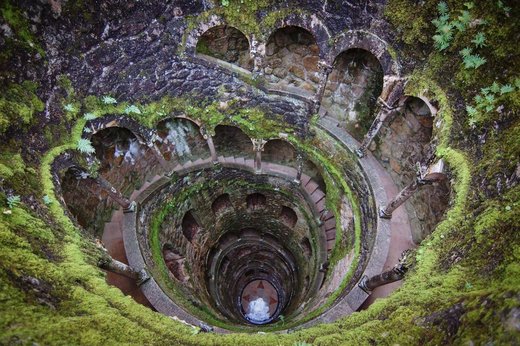
The day's beauty ended at Starfish Point. "It was a horror show," Fradkin told me. Instead of the usual spangling of purple, orange, and brick-red on the rocks, many of the starfish, which are known to biologists as sea stars, were contorted, marked with white lesions, or seemingly melting into goo. "They were missing arms," Fradkin said, "and there were even instances of arms walking around by themselves."
The team's observations are considered the first official record of an ongoing outbreak of a sea-star wasting disease that has killed millions of starfish from Baja California to southern Alaska, typically wiping out more than ninety per cent of each population it strikes. It's the greatest wildlife mass-mortality event, or "die-off," of the present day.
Mass-mortality events are sudden, unusual crashes in a population. On the spectrum of death—mortality's rainbow, if you will—they fill the space between the cool regularity of background death rates and the hot flare of species burning out into extinction. If you think that you are hearing about them more often these days, you're probably right. (Elizabeth Kolbert described frog and bat die-offs in a 2009 article; her subsequent book won a Pulitzer Prize this week.) Even mass-mortality experts struggle to parse whether we're witnessing a genuine epidemic (more properly, an epizootic) of these events. They have also raised another possibility: that we are in the throes of what one researcher called an "epidemic of awareness" of spooky wildlife deaths.
Die-off reports are fertile ground for latter-day anxieties. The events they describe tend to elude explanation, encouraging the notion that our private theories about why they happen are as legitimate as those of the baffled scientists. Of course, mass death also looks like seriously bad news. While we are bombarded with stories of environmental doom and gloom, many of the problems are effectively invisible. It's mainly mathematical models, for example, that tell us an extinction crisis is underway, mostly involving little-known species in little-known places. In an atmosphere of pervasive human guilt, if not eco-grief, it is easy to assume that wildlife mass-mortality events are cinematically graphic manifestations—melting starfish, birds falling from the sky—of the powerful foundational forces that drive more abstract challenges such as climate change.
The Internet has offered a wellspring of speculation about mass wildlife deaths. A case in point: more than four thousand red-winged blackbirds are found dead on New Year's Day, 2011, in Beebe, Arkansas. As the story spreads, news of other die-offs is reported from around the world. Dead jackdaws in Sweden. Dead velvet swimming crabs in the U.K. More dead blackbirds in Louisiana. Dead snapper in New Zealand ("many with their eyes missing"). Five days after the initial event, a Washington Post blogger dubs it "the Aflockalypse." The name sticks, and so does the implication. The Web is soon abuzz with commentators linking these occurrences to end-is-near prophecies, secret government experiments, and the threat of ecological collapse. The National Wildlife Health Center ultimately diagnoses the probable cause of the die-off as avian panic, most likely triggered by loud noises—possibly fireworks—too close to the birds' nighttime roost. Of course, nobody can say for sure.
Wildlife die-offs are an ancient phenomenon. One fossil site in Chile revealed recurring mass marine-mammal deaths, most likely from toxic algae blooms, dating back at least nine million years. Aristotle, in his "Historia Animalium," in the fourth century B.C., remarked on mass dolphin strandings as simply something that the animals were known to do "at times." The earliest written record in American history, from 1542, by the Spanish explorer Álvar Núñez Cabeza de Vaca, appears to indicate that Native Americans on Tampa Bay, in Florida, understood fish die-offs—which still occur in the area today—as typical of certain seasons.
At least in some quarters, the sudden death of large numbers of wild animals has been read as a dire message to humanity: scientists have pointed out that the first biblical plague of Egypt, a fish die-off in a blood-red Nile, is an apt description of the effects of the acidification of the river's water. Yet the widespread interpretation of such events as signs, whether ecological or divine, that humankind's abuse of the planet has gone too far appears to be relatively new.
Even oddball mortalities of the type that trigger apocalyptic anxiety today don't appear to cause much stir in the historical record. In 1884, hundreds of tons of dead fish bellied up in the lakes that surround Madison, Wisconsin, requiring daily burials by a crew of up to thirty-eight men with horse teams. During the "great bird shower" of 1904 in Minnesota and Iowa, millions of sparrow-like Lapland longspurs fell from the night sky, most of them dead but some hitting the ground as snowballs that then "hatched" live birds in the morning sun. Detailed reports of both events exist; they document public curiosity and conjecture, but very little sense that these die-offs represented any judgment on society.
Even thirty years ago, the public response to an unusually extreme mass-mortality event wasn't particularly fraught. In 1983, long-spined sea urchins, then a common Caribbean species, began to waste away; their bony casings soon littered shorelines from Panama to Florida. The species had been abundant for a long time, possibly hundreds of thousands of years, but within thirteen months its population had declined by ninety-eight per cent. Even today, the urchins number not much more than ten per cent of their former plenitude. Haris Lessios, a senior staff scientist with the Smithsonian Tropical Research Institute, in Panama, studied the urchin crash from the outset. He recalls little news coverage—indeed, the New York Times reported on the die-off only once, a year after it began—and no public interest beyond local residents, who were happy not to contend any longer with the urchins' painful sting. "I don't think anyone was particularly worried," Lessios told me. "I wasn't. I thought that within a few years things would be back to normal."
Like the urchin die-off, the 2013 sea-star-wasting-disease outbreak had a terrible impact over an enormous geographic range. By contrast, however, references to melting starfish and their detached zombie limbs appeared everywhere from National Geographic to Fox News to the End Times Prophecy. Starfish are a beloved ocean icon, and the public reaction was twofold: expressions of sadness, often accompanied by offers of help (observations by "citizen scientists" contributed to what is probably the largest data set ever assembled about a marine-animal disease outbreak), and generalized concern that human beings must be responsible—and might be next.
Pete Raimondi, a University of California, Santa Cruz, marine biologist who is the principal investigator with a research group studying the event, said that, after the news broke, he responded to hundreds of reporters and "volumes and volumes" of calls, e-mails, blog posts, and personal contacts from citizens. "That's the highest level of anxiety I've ever seen," Raimondi said. "People were not only worried about the environment, they were worried about themselves." Online, speculation about the cause of the die-off soon focussed on radiation from the Fukushima Daiichi nuclear-power plant, which had been badly damaged by the tsunami that struck Japan in 2011. Raimondi recalled a phone call in which a fearful soon-to-be father asked whether he should immediately move his family away from the West Coast. It was one of many similarly heartfelt calls. Researchers have found no evidence of a link between the ongoing Fukushima disaster and the starfish die-off, Raimondi said—"very massive sampling" indicates that the outbreak began before waterborne radiation reached the coast. Many members of the public remain unconvinced.
Broadly speaking, however, the gap between the public perception of die-offs and the scientific interpretation is not so wide. Until recently, most biologists tended to look at mass-mortality events as isolated incidents with case-specific causes. As a result, it has been the convention among major media sources to present die-offs as at once mysterious and alarming, but also ordinary and even natural. The pattern is not unlike telling ghost stories to children while scolding them for being afraid. Several disquieting tales have already made the 2015 news cycle, most notably hundreds of dying sea-lion pups that began turning up on California beaches in January, and two thousand snow geese that dropped out of the sky to die in Idaho in March. Such phenomena really are relatively commonplace.
Comment: Absolute tosh. How can the deaths of at least 10,000 thousand (not 'hundreds') sea-lion pups since January be deemed 'relatively commonplace' in any way. This looks be a case of establishing 'facts' by simple assertion. Geez, talk about normalcy bias!
At the time of this writing, the National Wildlife Health Center had recorded fifty-six mass-mortality events in the U.S. so far this year, among them the sudden deaths of fifty black vultures in Ascension Parish, Louisiana; thirteen hundred waterfowl in Humboldt County, California; and two thousand bats in Pierce County, Wisconsin.
Yet recent research suggests that the perception of wildlife die-offs as more frequent and alarming than ever might have some basis in fact. In January, the first study ever to attempt to track trends in mass-mortality events was published in Proceedings of the National Academy of Sciences; the authors found that die-offs appear to be increasing in both number and magnitude, even after attempting to correct statistically for the fact that mass deaths are more likely to be documented today than they were in the past. Bird die-offs, for example, have historically been among the best represented in the scientific literature. The study's authors had expected that an increase in the reporting of such events would add a larger number of less dramatic cases—in which fewer birds die—to the over-all data set, bringing down the average number of deaths per occurrence. Instead, they found the opposite. The typical number of bird deaths per reported die-off has risen, from about a hundred in the nineteen-forties to some ten thousand today. The over-all number of bird die-offs also seems to have increased. "That paper supports a lot of what many of us have been suspecting," Jonathan Sleeman, a wildlife epidemiologist who heads the National Wildlife Health Center, said. "I do think we're seeing more catastrophic events."
Every biologist I spoke with who is researching mass-mortality events said that many wildlife die-offs today really could be signals of serious problems with the ecological fundamentals of the planet. Last year, a team of scientists found that sea-star wasting disease is caused by a virus-size organism (and therefore probably a virus). Given that similar, though lesser, outbreaks have occurred in the past, the current epizootic could be perfectly natural, nothing more than a particularly dangerous strain of a virus. Yet sea stars are known to be maritime canaries-in-the-coal-mine: "They're always the first ones to go," Raimondi said. Radiation from Japan may have been ruled out as the epizootic's catalyst, but a long list of other big-picture environmental stressors are under investigation for possibly having made the sea stars more susceptible to disease, among them temperature spikes (which may be related to climate change), ocean acidification, pollution, or some combination of the above or other pressures. It's not crazy to think that mass deaths of wildlife are telling us something about the state of the world, Raimondi said, but it remains important to let the evidence speak case by case. "If they're going to be stressed, then they should be stressed about things that are real," he said.
If the starfish die-off proves to have been exacerbated by human causes, could it be a warning of an imminent ecological catastrophe? The answer may depend on your definition of catastrophe. "You're not going to go from these really healthy, stable ecosystems to collapse," Raimondi said. "That's not to say that things aren't going to change."
When the long-spined sea urchin crashed in the Caribbean in 1983, it led to what scientists call a "phase shift" in the marine environment. The urchins were important grazers of seaweed. With the urchins gone, seaweed surged, overgrowing coral reefs. Caribbean reefs had already been under duress from overfishing, pollution, and other factors, but the urchin die-off appears to have been a tipping point. The most visually spectacular shallow-water reefs in the Caribbean today are less impressive than even an average reef of thirty years ago.
Oddly, what Raimondi called the "worst-case scenario" for the sea-star die-off is the opposite of what happened in the Caribbean. On the Pacific coast, the big, habitat-forming structures are not coral reefs but underwater "forests" of seaweed. Starfish eat sea urchins; without them, urchins may mow down the kelp forests. That in turn can call up a roster of changes that range from more frequent eagle attacks on seabirds to higher waves striking the shore: not the end of the world, but a different world—and, ecologically speaking, a poorer one.
It might not happen that way, of course. Nature is full of surprises. Observers on the West Coast this spring are reporting more baby starfish, many no bigger than a fingernail, at more sites than at any time in the past fifteen years. The best current explanation for this supernova of cuteness is that the onset of wasting disease triggered starfish to reproduce intensively before dying. "If they survive, it means recovery may be underway," Raimondi said of the tiny sea stars. "If they grow up and start wasting away, well, that's a different story." These days, this may qualify as hope.



For some, the test tube is half-empty.
For others, it is half-full.
Getting grant money, enough to really live high on, is always a challenge.
You have to make it look and feel good.
One must become a real whore.
The awards (and a full test tube), will follow.
ned, out